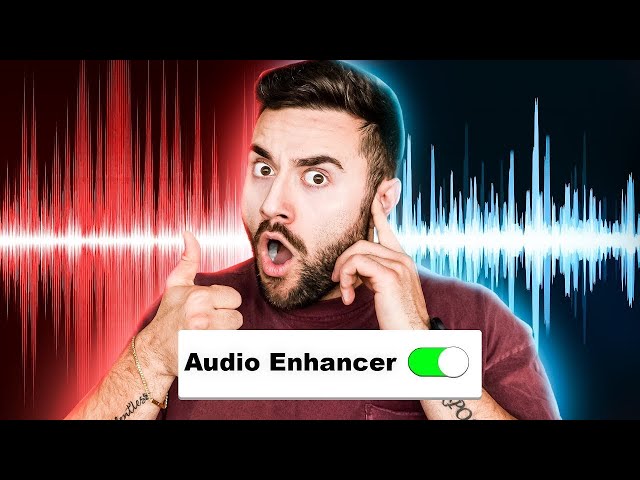If you’re looking to create high-quality faceless videos, one of the key elements to consider is the audio quality. Captivating the attention of your audience goes beyond just visuals, and having clear, crisp audio can make a significant difference in the impact of your videos. In this article, we will explore some tips and tricks to enhance the audio quality in your faceless videos, allowing you to deliver an immersive and engaging experience to your viewers. Whether you’re a content creator, educator, or business professional, these techniques will help you achieve professional-level audio in your recordings. So, let’s dive in and discover how to take your faceless videos to the next level with enhanced audio quality!

This image is property of i.ytimg.com.
Understanding the Importance of Audio Quality
Impact of audio on video engagement
When it comes to creating faceless videos, audio quality is often overlooked. However, it plays a crucial role in capturing and maintaining the attention of your audience. Think about it – have you ever watched a video with poor audio, where you struggled to understand what was being said? It can quickly become frustrating and lead to disengagement.
High-quality audio, on the other hand, can significantly enhance the viewer’s experience. It allows them to fully comprehend the content and ensures that your message is effectively conveyed. Clear audio quality also helps establish credibility, demonstrating a level of professionalism and attention to detail in your videos.
Importance of clear and high-quality audio
Clear and high-quality audio is essential for several reasons. Firstly, it makes your content more accessible to a wider audience. People with hearing impairments heavily rely on clear audio to understand the information presented in videos. Secondly, it improves the overall viewing experience, making your videos more enjoyable and captivating. Finally, clear audio can influence the perception of your brand or business, as it reflects the level of professionalism and care you put into your content.
Setting Up the Recording Environment
Choosing a suitable location
When recording faceless videos, selecting the right location is crucial for achieving optimal audio quality. Ideally, you want to choose a quiet space with minimal background noise. Avoid areas near busy streets, air vents, or any other potential sources of unwanted noise.
If you don’t have access to a soundproof room, consider using blankets, curtains, or foam panels to help absorb and minimize echo or reverberation. Creating a dedicated recording space can greatly improve the audio quality of your faceless videos.
Minimizing background noise
Background noise can severely impact the clarity and quality of your audio. To minimize unwanted noise, start by turning off any appliances or electronics that emit noise. Additionally, close windows and doors to reduce external sounds.
It’s also important to be mindful of other potential noise sources, such as air conditioning units or fans. If possible, turn them off while recording. By taking these simple steps, you can significantly reduce background noise and improve the audio quality of your faceless videos.
Using acoustic treatments
If you find that your recording environment still has unwanted echoes or reverberation, consider utilizing acoustic treatments. These can include foam panels, bass traps, or diffusers, which help absorb and disperse sound waves, reducing echo and enhancing the overall audio quality.
Acoustic treatments are particularly useful in home recording setups, where rooms may not be designed with sound isolation in mind. By strategically placing these treatments in your recording space, you can create a more controlled and favorable acoustic environment.
Selecting the Right Microphone
Types of microphones for faceless videos
There are several types of microphones commonly used for faceless videos, each with its own strengths and weaknesses. The choice of microphone will depend on factors such as the recording environment, intended use, and personal preference.
-
Lavalier Microphones: These small, clip-on microphones are commonly used in broadcasting or situations where hands-free operation is required. Lavalier microphones are discreet and offer good voice clarity, making them suitable for faceless videos where movement is involved.
-
Shotgun Microphones: Shotgun microphones are highly directional and focus on capturing sound from specific sources while rejecting ambient noise. They are often used in professional video production and are commonly mounted on a boom pole or camera.
-
USB Microphones: USB microphones are plug-and-play devices that connect directly to your computer’s USB port. They are popular among content creators and vloggers due to their simplicity and ease of use.
Considerations for microphone selection
When selecting a microphone for your faceless videos, consider the following factors:
-
Sound Quality: Opt for a microphone that delivers clear and accurate sound reproduction. This will ensure that your voice is captured with fidelity and without unwanted noise or distortion.
-
Compatibility: Ensure that the microphone you choose is compatible with your recording setup. Consider factors such as connection types (XLR, USB) and compatibility with your recording device or software.
-
Directionality: Think about the recording environment and the type of audio you’ll be capturing. Different microphones have different pickup patterns, such as omnidirectional, cardioid, or hypercardioid. Choose a microphone with a pickup pattern that matches your needs.
Recommended microphones for different scenarios
-
Lavalier Microphone: Rode SmartLav+ is a popular choice for faceless videos that require mobility and hands-free operation. It offers excellent audio quality and is compatible with smartphones and other devices.
-
Shotgun Microphone: Audio-Technica AT875R is a highly regarded shotgun microphone suitable for professional videography. It provides focused audio capture and is often used in filmmaking and broadcasting.
-
USB Microphone: Blue Yeti USB Microphone is a versatile and widely used USB microphone that delivers high-quality audio. It offers multiple pickup patterns, making it suitable for various recording scenarios.
Ultimately, the choice of microphone will depend on your specific needs, budget, and recording setup.
Optimizing Microphone Placement
Positioning the microphone correctly
Proper placement of the microphone is crucial for capturing optimal audio quality in your faceless videos. The exact placement will depend on the type of microphone you’re using and the desired sound.
When using a lavalier microphone, position it near the speaker’s mouth, ensuring it is securely attached. This will help capture the voice clearly and minimize background noise.
For shotgun microphones, position them just out of frame but close to the sound source. This placement allows the microphone to capture the desired audio while minimizing ambient noise.
Maintaining appropriate distance
Maintaining the correct distance between the microphone and sound source is essential to achieve balanced audio levels and avoid unwanted distortion or muffled sounds. The optimal distance will vary depending on the microphone and the recording environment.
As a general guideline, aim for a distance of 6-12 inches from the microphone for lavalier microphones. For shotgun microphones, a distance of around 1-3 feet is recommended.
Experiment with different distances to find the sweet spot that captures the desired sound quality for your faceless videos.
Avoiding common microphone placement mistakes
Avoid placing the microphone too close to the mouth, as it can result in plosive sounds (pops) and exaggerated mouth noises. It’s also important to avoid placing the microphone too far away, as it can pick up more ambient noise, resulting in a less clear and focused audio.
Additionally, be mindful of any potential obstructions that may affect the microphone’s performance. Keep an eye out for clothing rustling against the microphone or objects blocking the microphone’s line of sight to the sound source.
By avoiding these common microphone placement mistakes, you can ensure the best possible audio quality for your faceless videos.

This image is property of www.ezoic.com.
Using Pop Filters and Windshields
The purpose of pop filters and windshields
Pop filters and windshields serve an important role in improving the audio quality of your faceless videos.
Pop filters are mesh screens placed in front of the microphone to reduce or eliminate plosive sounds (pops) caused by bursts of air hitting the microphone capsule. These pops often occur when pronouncing words that contain strong plosive sounds, such as “p,” “b,” or “t.” Pop filters diffuse the burst of air, resulting in smoother and more intelligible audio.
Windshields, on the other hand, are foam or furry covers designed to reduce wind noise and mitigate the impact of airflow on the microphone. They are particularly useful for outdoor recordings or situations where there is a significant amount of air movement.
Benefits of reducing plosive sounds
Reducing plosive sounds is crucial for achieving clear and professional audio in your faceless videos. When plosive sounds are left unaddressed, they can cause sudden spikes in the audio waveform, resulting in distorted, unpleasant listening experiences for your viewers.
By using a pop filter, you can effectively minimize these plosive sounds, resulting in a smoother, more natural vocal delivery. This, in turn, enhances the overall audio quality and ensures that your message is conveyed clearly and professionally.
Choosing the right pop filter for your microphone
When selecting a pop filter, make sure it is compatible with the microphone you are using and matches its size and design. Some microphones come with built-in pop filters, while others may require an external pop filter to be attached.
Consider the material of the pop filter, as different materials can have varying effects on the audio. Generally, a fine-mesh metal pop filter is recommended as it effectively diffuses bursts of air while causing minimal high-frequency loss.
Ensure that the pop filter is securely mounted and positioned close to the microphone for optimal performance. By choosing the right pop filter and using it correctly, you can significantly improve the audio quality of your faceless videos.
Adjusting Recording Levels
Avoiding audio clipping
Audio clipping occurs when the audio signal exceeds the maximum level that can be accurately recorded or reproduced. This results in distorted, unpleasant sound and can significantly affect the overall audio quality of your faceless videos.
To avoid audio clipping, make sure to monitor the recording levels and ensure that they stay within an acceptable range. Avoid setting the recording levels too high, as this increases the risk of clipping. Instead, aim for a steady, moderate level that allows the audio to be accurately captured without distortion.
Setting proper gain levels
Setting proper gain levels is essential for achieving a balanced and well-recorded audio signal. Gain refers to the amplification of the audio signal, and it determines the overall volume of the recording.
When setting the gain, aim for a level that allows the audio to be heard clearly without being too soft or excessively loud. It’s important to find the right balance that maintains the integrity of the audio while avoiding unnecessary noise or distortion.
You can adjust the gain using the volume controls on your recording device or interface. Keep in mind that different microphones may require different gain settings, so it’s important to experiment and find the optimal level for each specific scenario.
Creating a balanced audio signal
Achieving a balanced audio signal is crucial to ensure that all elements of your faceless video can be heard clearly. This includes not only the speaker’s voice but also any background music or sound effects.
When editing your video, make sure to adjust the audio levels to create a sense of balance and cohesion. This involves ensuring that the voice is clear and prominent, while any background music or sound effects are at an appropriate level that complements the overall content.
By paying attention to the recording and editing process, you can create a well-balanced audio signal that enhances the viewer’s experience and maintains their engagement.
Utilizing Post-Processing Techniques
Removing background noise
Even with a well-planned recording setup, it’s not uncommon to have some residual background noise that needs to be addressed during post-processing. Background noise can include things like low-frequency hums, air conditioning noise, or electronic interference.
To remove background noise, you can use specialized audio editing software that offers noise reduction or restoration tools. These tools analyze the audio and allow you to isolate and reduce specific frequencies or sounds, effectively minimizing unwanted background noise.
However, it’s important to note that excessive noise reduction can sometimes result in artifacts or unnatural-sounding audio. Therefore, it’s important to use these tools judiciously and find a balance that maintains the integrity of the audio while reducing the background noise.
Equalizing the audio
Equalization, or EQ, is the process of adjusting the frequency response of the audio to enhance or correct specific elements. It allows you to emphasize certain frequencies or reduce the prominence of others, ultimately improving the overall audio quality.
When equalizing the audio for your faceless videos, consider the specific characteristics of the speaker’s voice and the overall tone you want to achieve. For example, you may want to boost the mid-range frequencies to ensure clarity in speech or attenuate certain frequencies that sound harsh or unnatural.
It’s important to approach equalization with subtlety and pay attention to the overall balance of the audio. Excessive or inappropriate equalization can result in an unnatural sound or imbalanced frequency response.
Applying compression and normalization
Compression and normalization are audio processing techniques commonly used to enhance the audio quality and ensure consistent volume levels throughout your faceless videos.
Compression is used to reduce the dynamic range of the audio, making quieter elements louder and louder elements quieter. It helps balance the audio levels, making it easier for viewers to hear everything clearly. Compression can also help control sudden volume spikes, resulting in a smoother and more polished sound.
Normalization, on the other hand, adjusts the volume levels to a specific target level, typically the maximum allowed level without clipping or distortion. This ensures that all parts of your video have a consistent volume and reduces the need for viewers to continually adjust their volume settings.
When using compression and normalization, it’s important to strike a balance between achieving desired audio clarity and maintaining a natural sound. Overusing these techniques can lead to audio artifacts or an artificial, overprocessed sound. Experimentation and careful adjustment are key to obtaining optimal results.
Choosing Suitable Background Music
Adding depth and mood to faceless videos
Background music can greatly enhance the viewer’s experience and add depth and mood to your faceless videos. Well-chosen music can evoke emotions, create a sense of atmosphere, and keep the audience engaged throughout the video.
Carefully consider the tone and message of your video before selecting background music. Is it a lighthearted and upbeat video, or is it more serious and informative? Choose music that complements the content and creates a harmonious blend with the spoken words.
Background music should never overpower the speaker’s voice or distract the viewer from the main message. It should be subtle yet impactful, providing a pleasant backdrop that enhances the overall viewing experience.
Avoiding copyright infringement
When choosing background music for your faceless videos, it’s important to respect copyright laws and obtain proper licensing or use royalty-free music. Using copyrighted music without permission can lead to legal consequences and tarnish your reputation as a content creator.
Thankfully, there are numerous platforms that offer a wide range of royalty-free and copyright-free music for various purposes. Explore these platforms and select music that suits your video while adhering to copyright regulations. This way, you can ensure a legal, hassle-free, and professional approach to incorporating background music.
Optimizing background music levels
Once you’ve selected the appropriate background music, it’s crucial to adjust its volume levels appropriately. The music should never overpower the spoken words, as this can make it difficult for viewers to understand the content of your faceless video.
During the editing process, carefully adjust the volume of the background music to create a perfect balance with the speaker’s voice. The objective is to have the music enhance the video without competing for attention. Test the audio levels on different devices to ensure that the music remains pleasant and complementary no matter how it is listened to.
By optimizing the background music levels, you can create a harmonious audio mix that captivates the audience while delivering your message effectively.

This image is property of digitalnomadcafe.com.
Considering Voiceover Artists
Hiring professional voiceover artists
In some faceless videos, you may choose to hire professional voiceover artists to deliver the narration or provide additional vocal elements. Professional voiceover artists bring their expertise, vocal range, and expression to the table, enhancing the audio quality and overall impact of your videos.
When hiring voiceover artists, look for individuals with experience in delivering voiceover work for videos or other media. Consider their vocal qualities, ability to adapt to different script requirements, and attention to detail. Ask for samples or demos to ensure they align with the tonal requirements of your video.
Working with professional voiceover artists can greatly elevate the audio quality of your faceless videos, providing a polished, authoritative, and engaging vocal presentation.
Recording voiceovers for faceless videos
If you choose to record voiceovers for your faceless videos yourself, it’s important to maintain vocal clarity and expression. Follow the recording setup and techniques mentioned earlier to ensure optimal audio quality.
When recording voiceovers, pay attention to your pacing, articulation, and tone. Speak clearly and naturally, using appropriate variation in pitch and volume to convey emotions or emphasize certain points. Take your time and record multiple takes if necessary to ensure you capture the desired delivery.
Remember to maintain consistency between your voiceover segments, especially if your video contains multiple voiceover sections. Consistent audio levels, tone, and vocal style contribute to a professional and cohesive final product.
Ensuring vocal clarity and expression
Regardless of whether you hire professional voiceover artists or record voiceovers yourself, ensure that vocal clarity and expression are prioritized in your faceless videos. Clear and expressive vocals are key to capturing and maintaining your viewers’ attention, ensuring that your message is conveyed effectively.
Pay attention to enunciation, avoid mumbling or speaking too fast, and strive for a balanced vocal delivery. Practice reading the script or rehearsing the spoken parts to familiarize yourself with the content and find a comfortable pace and tone.
By prioritizing vocal clarity and expression, you can further elevate the audio quality of your faceless videos and make a lasting impact on your audience.
Testing and Monitoring Audio Quality
Using headphones for monitoring
Monitoring your audio during recording and post-processing is crucial for ensuring optimal audio quality in your faceless videos. Headphones, rather than relying on the built-in speakers of your recording device, provide a more accurate representation of the audio.
Using headphones allows you to detect any imperfections, background noise, or distortion that may not be easily noticeable through speakers. They provide a more detailed, isolated listening experience, giving you better control over the audio quality.
When monitoring with headphones, make sure they are of good quality and provide a flat frequency response. This ensures that the audio reproduction is accurate and reflects what your viewers will hear.
Performing sound checks and tests
Before recording your faceless videos, it’s important to perform sound checks and tests to ensure the audio quality is up to par. This involves checking the microphone’s functionality, the recording device’s settings, and the overall audio signal.
Start by testing the microphone by recording a short sample and listening back to it. Ensure that the voice is clear, background noise is minimal, and there are no technical issues such as static or distortion.
Next, check the recording device’s settings, making sure that the gain levels are appropriate and the audio input/output settings are configured correctly.
Finally, perform a thorough sound check by recording a few minutes of audio and playing it back to identify any potential issues. This allows you to address any problems before proceeding with the actual recording, saving you time and ensuring a smoother workflow.
Continuous improvement through feedback
As you create and publish faceless videos, it’s important to gather feedback from your viewers regarding the audio quality. Encourage them to provide feedback on factors such as clarity, background noise, or any other audio-related aspects.
Analyze the feedback received and identify areas for improvement. Take note of recurring comments or suggestions and consider how they can be integrated into your future videos. This continuous feedback loop allows you to refine and enhance your audio quality over time, ensuring that your faceless videos consistently deliver a high-quality listening experience.
In conclusion, capturing high-quality audio for your faceless videos is essential in effectively conveying your message, engaging your viewers, and enhancing the overall viewing experience. By understanding the importance of audio quality, setting up the recording environment appropriately, selecting the right microphone, optimizing microphone placement, using pop filters and windshields, adjusting recording levels, utilizing post-processing techniques, choosing suitable background music, considering voiceover artists, testing and monitoring audio quality, and continuously seeking feedback for improvement, you can ensure that your faceless videos sound professional, clear, and captivating. Remember, audio quality is just as important as visual quality when it comes to creating impactful and memorable content.

This image is property of i0.wp.com.


